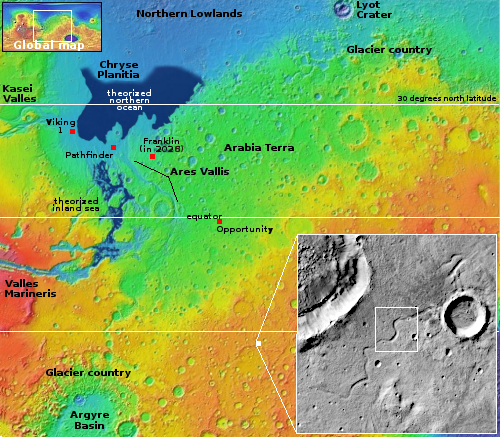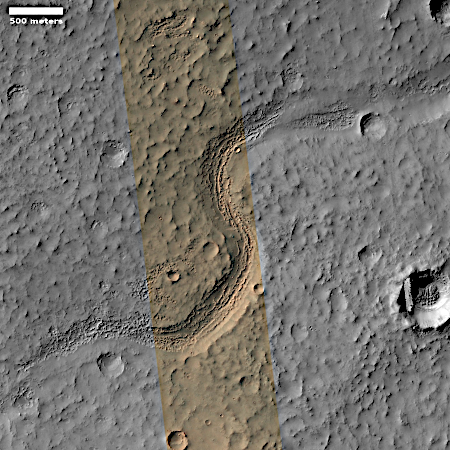Meandering channel in Mars’ southern cratered highlands
Cool image time! The picture to the right, cropped, reduced, and sharpened to post here, was taken on August 30, 2025 by the high resolution camera on Mars Reconnaissance Orbiter (MRO).
Dubbed a “channel” by the MRO science team, it shows us a meandering canyon with a floor that seems filled with corroded linear features seen frequently on Earth glaciers. Here, the linear ridges appear broken, in many places missing, and in other places so broken their linear nature disappears.
If this was on Earth and I was a global warming activitist, I would immediately claim that the glacier has been evaporating away due to a warming climate caused by SUVs and Republican intransigence. This however is on Mars, where there are no SUVs or Republicans. So what is going on?

The white dot on the overview map to the right marks this location, in the southern cratered highlands of Mars and at about 33 degrees south latitude. The inset shows us that this meandering channel extends about nine miles westward from a 2.4-mile-wide unnamed crater. Strangely there is no clear downhill grade, with the ground rising and falling unevenly all along the length of this channel. Nor does there appear to be a gap in the crater wall allowing ice or water to flow in or out along this channel.
That there is another small section of unattached meandering channel visible in the inset to the north gives us the best clue for explaining this geology. The channel probably existed first, formed by the near-surface ice that exists above 30 degrees latitude on Mars. Or maybe it was formed by fast-flowing Martian lava, as this region has a number of volcanic vents scattered about that are hard to spot, and then later filled with glacial ice as the Martian climate went through its many climate cycles.
Then the impact occurred, creating the crater and destroying that part of the channel. In subsequent eons the overall grade of this terrain shifted, so that the original downhill direction is no longer evident. Furthermore, the climate over time changed as Mars’ rotational tilt swung wildly from 11 to 60 degrees tilt, causing that ice to sublimate away.
At least, that’s my back-of-the-envelope theory. Take it for what it is worth.
On Christmas Eve 1968 three Americans became the first humans to visit another world. What they did to celebrate was unexpected and profound, and will be remembered throughout all human history. Genesis: the Story of Apollo 8, Robert Zimmerman's classic history of humanity's first journey to another world, tells that story, and it is now available as both an ebook and an audiobook, both with a foreword by Valerie Anders and a new introduction by Robert Zimmerman.
The print edition can be purchased at Amazon or from any other book seller. If you want an autographed copy the price is $60 for the hardback and $45 for the paperback, plus $8 shipping for each. Go here for purchasing details. The ebook is available everywhere for $5.99 (before discount) at amazon, or direct from my ebook publisher, ebookit. If you buy it from ebookit you don't support the big tech companies and the author gets a bigger cut much sooner.
The audiobook is also available at all these vendors, and is also free with a 30-day trial membership to Audible.
"Not simply about one mission, [Genesis] is also the history of America's quest for the moon... Zimmerman has done a masterful job of tying disparate events together into a solid account of one of America's greatest human triumphs."--San Antonio Express-News
Cool image time! The picture to the right, cropped, reduced, and sharpened to post here, was taken on August 30, 2025 by the high resolution camera on Mars Reconnaissance Orbiter (MRO).
Dubbed a “channel” by the MRO science team, it shows us a meandering canyon with a floor that seems filled with corroded linear features seen frequently on Earth glaciers. Here, the linear ridges appear broken, in many places missing, and in other places so broken their linear nature disappears.
If this was on Earth and I was a global warming activitist, I would immediately claim that the glacier has been evaporating away due to a warming climate caused by SUVs and Republican intransigence. This however is on Mars, where there are no SUVs or Republicans. So what is going on?

The white dot on the overview map to the right marks this location, in the southern cratered highlands of Mars and at about 33 degrees south latitude. The inset shows us that this meandering channel extends about nine miles westward from a 2.4-mile-wide unnamed crater. Strangely there is no clear downhill grade, with the ground rising and falling unevenly all along the length of this channel. Nor does there appear to be a gap in the crater wall allowing ice or water to flow in or out along this channel.
That there is another small section of unattached meandering channel visible in the inset to the north gives us the best clue for explaining this geology. The channel probably existed first, formed by the near-surface ice that exists above 30 degrees latitude on Mars. Or maybe it was formed by fast-flowing Martian lava, as this region has a number of volcanic vents scattered about that are hard to spot, and then later filled with glacial ice as the Martian climate went through its many climate cycles.
Then the impact occurred, creating the crater and destroying that part of the channel. In subsequent eons the overall grade of this terrain shifted, so that the original downhill direction is no longer evident. Furthermore, the climate over time changed as Mars’ rotational tilt swung wildly from 11 to 60 degrees tilt, causing that ice to sublimate away.
At least, that’s my back-of-the-envelope theory. Take it for what it is worth.
On Christmas Eve 1968 three Americans became the first humans to visit another world. What they did to celebrate was unexpected and profound, and will be remembered throughout all human history. Genesis: the Story of Apollo 8, Robert Zimmerman's classic history of humanity's first journey to another world, tells that story, and it is now available as both an ebook and an audiobook, both with a foreword by Valerie Anders and a new introduction by Robert Zimmerman.
The print edition can be purchased at Amazon or from any other book seller. If you want an autographed copy the price is $60 for the hardback and $45 for the paperback, plus $8 shipping for each. Go here for purchasing details. The ebook is available everywhere for $5.99 (before discount) at amazon, or direct from my ebook publisher, ebookit. If you buy it from ebookit you don't support the big tech companies and the author gets a bigger cut much sooner.
The audiobook is also available at all these vendors, and is also free with a 30-day trial membership to Audible.
"Not simply about one mission, [Genesis] is also the history of America's quest for the moon... Zimmerman has done a masterful job of tying disparate events together into a solid account of one of America's greatest human triumphs."--San Antonio Express-News


